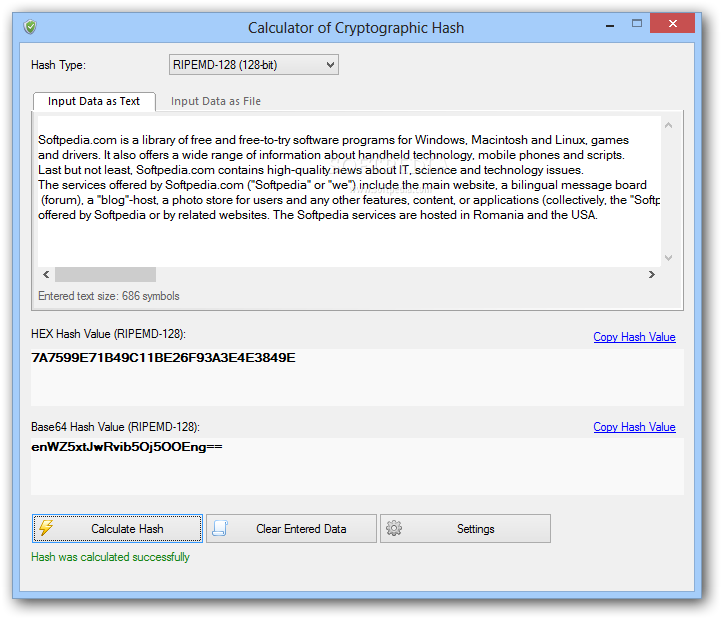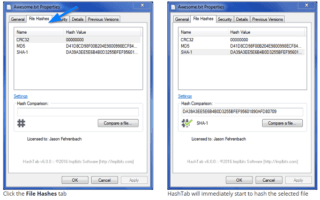

- WINDOWS PROPERTY SHEET HASH CALCULATOR CODE
- WINDOWS PROPERTY SHEET HASH CALCULATOR PASSWORD
- WINDOWS PROPERTY SHEET HASH CALCULATOR SERIES
- WINDOWS PROPERTY SHEET HASH CALCULATOR DOWNLOAD
The only effective way to reverse engineer a computed SHA256 hash value back to the input bitstring is through a brute-force search, which means trying every possible input bitstring until a match with the target hash value is found. By the way, SHA256 is not susceptible to a length extension attack. For an input bitstring of any length N > 0, this function generates a fixed-length hash value of 256 bits hence, this hash value does not reveal even the input bitstring’s length N, let alone the value of each bit in the string. Recall, for example, the SHA256 hash function. Hash value->|chf inverse|->foobar # intractable
WINDOWS PROPERTY SHEET HASH CALCULATOR PASSWORD
Here is a depiction, with chf as a cryptographic hash function and my password foobar as the sample input: +-+įoobar->|chf|->hash value # straightforwardīy contrast, the inverse operation is infeasible: +-+ A cryptographic hash function should be relatively straightforward to compute, but computing its inverse-the function that maps the hash value back to the input bitstring-should be computationally intractable. What special property should a cryptographic hash function have? It should be one-way, which means very difficult to invert. The fingerprint from an incoming certificate can be compared against the truststore keys for a match. An in-memory truststore could be implemented as a lookup table keyed on such fingerprints-as a hash map, which supports constant-time lookups. An X509 digital certificate includes a hash value known as the fingerprint, which can facilitate certificate verification. HMAC codes, which are lightweight and easy to use in programs, are popular in web services.
WINDOWS PROPERTY SHEET HASH CALCULATOR CODE
For example, hash-based message authentication code ( HMAC) uses a hash value and a secret cryptographic key to authenticate a message sent over a network. Hash values also occur in various areas of security. Your password may be sent to the web server, but the site can assure you that the password is not stored there. It’s far less risky is to store a hash generated from a password, perhaps with some salt (extra bits) added to taste before the hash value is computed. What should be stored in this lookup table? Storing the passwords themselves is risky. Once the password arrives at the server, it's decrypted for a database table lookup. Their password is then sent, encrypted, from the browser to the server via an HTTPS connection to the server. Consider a website that requires users to authenticate with a password, which the user enters in their browser. (Low-level network protocols such as UDP do not bother with checksums.) In this case, the message and its checksum should be sent again, or at least an error condition should be raised. If the sent and the recomputed checksum do not match, then something happened to the message in transit, or to the sent checksum, or to both. The receiver recomputes the checksum when the message arrives. The message sender computes the message’s checksum and sends the results along with the message. Network protocols use hash values as well-often under the name checksum-to support message integrity that is, to assure that a received message is the same as the one sent. During a peak time in 2018, Bitcoin miners worldwide generated about 75 million terahashes per second-yet another incomprehensible number. (The value of N can go up or down depending on how productive the mining is at a particular time.) As a point of interest, today’s miners are hardware clusters designed for generating SHA256 hashes in parallel. To mine a Bitcoin is to generate a SHA256 hash value that falls below a specified threshold, which means a hash value with at least N leading zeroes. For example, the Bitcoin blockchain uses SHA256 hash values as block identifiers. Hashes are used in many areas of computing. OpenSSL itself provides similar command-line utilities. Linux, for instance, has md5sum and sha256sum.

Modern systems have utilities for computing such hashes. These values can be used to verify that the downloaded file matches the original in the repository: The downloader recomputes the hash values locally on the downloaded file and then compares the results against the originals. Each version comes with two hash values: 160-bit SHA1 and 256-bit SHA256.
WINDOWS PROPERTY SHEET HASH CALCULATOR DOWNLOAD
The download page for the OpenSSL source code ( ) contains a table with recent versions. Let’s begin with hashes, which are ubiquitous in computing, and consider what makes a hash function cryptographic.

This second article drills down into the details.
WINDOWS PROPERTY SHEET HASH CALCULATOR SERIES
The first article in this series introduced hashes, encryption/decryption, digital signatures, and digital certificates through the OpenSSL libraries and command-line utilities.


 0 kommentar(er)
0 kommentar(er)
